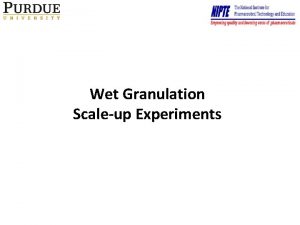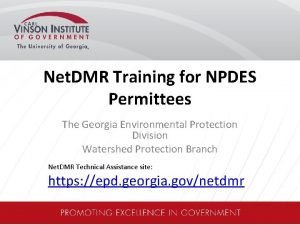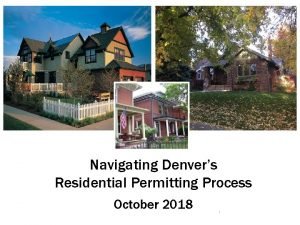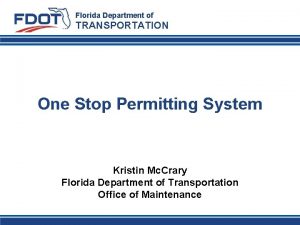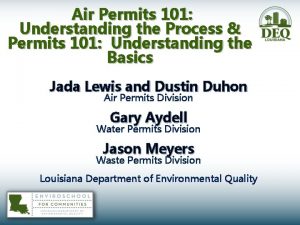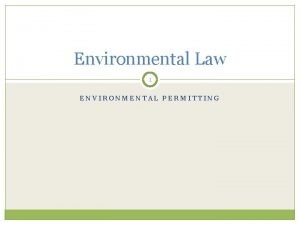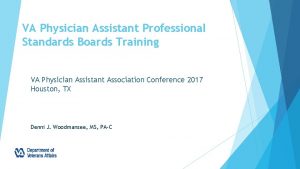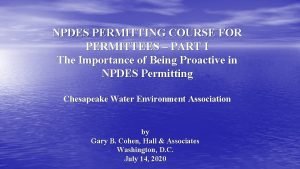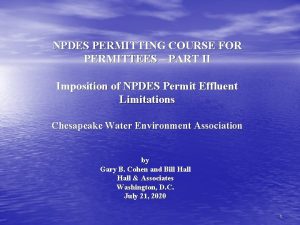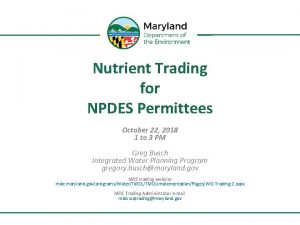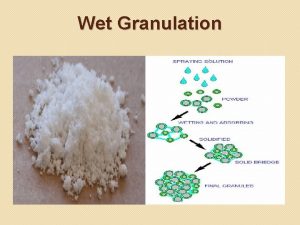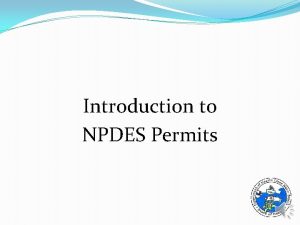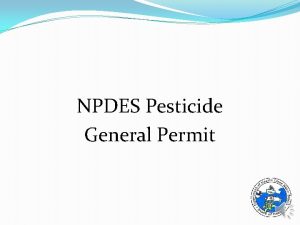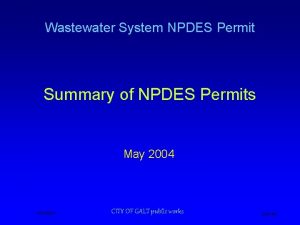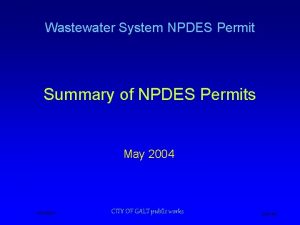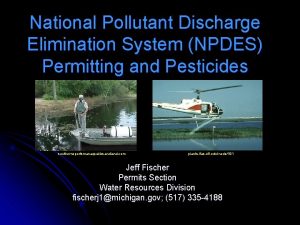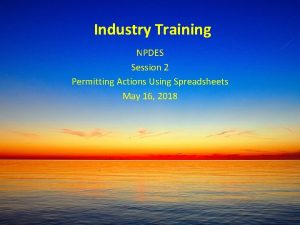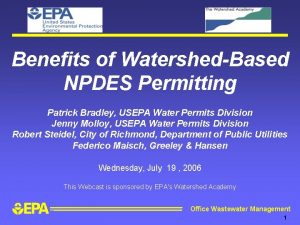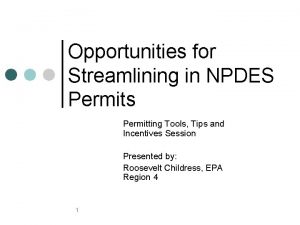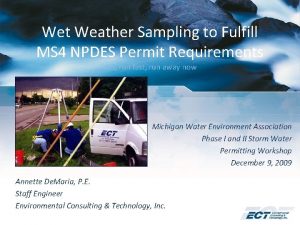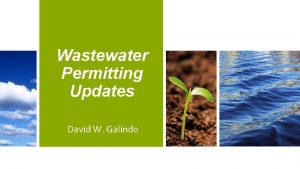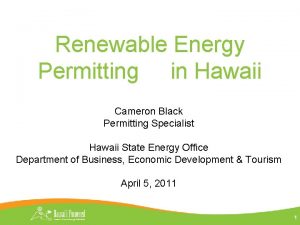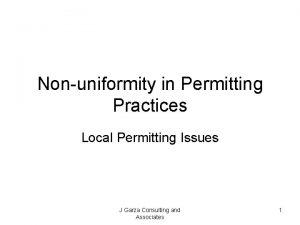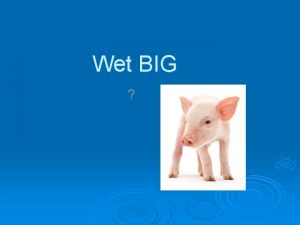NPDES PERMITTING COURSE FOR PERMITTEES PART III Wet






































- Slides: 38

NPDES PERMITTING COURSE FOR PERMITTEES – PART III Wet Weather and Nutrients Chesapeake Water Environment Association by Gary B. Cohen and Bill Hall & Associates Washington, D. C. July 28, 2020 1

WET WEATHER ISSUES • Sanitary Sewer Overflows (“SSO”) • Blending • Combined Sewer Overflows (“CSO”) • Municipal Separate Storm Sewer System (“MS 4”) Permitting 2

OVERFLOWS - CWA STANDARD • Unpermitted “Discharges” of Pollutants are Prohibited. • Other “Releases” from the Collection System are not, per se, Prohibited. 3

WHAT IS AN “OVERFLOW” THAT TRIGGERS POTENTIAL LIABILITY? Hall & Associates 4

REGULATORY PERSPECTIVE • Standard Depends Upon What the State Regulations Provide - e. g. , Tennessee Regulations Used to Have a No Feasible Alternative Defense for Overflows - Iowa Expanded Bypass Rule to the Collection System • LEGAL LIABILITY DEPENDS UPON YOUR PERMIT! 5

SAMPLE PERMIT LANGUAGE DEPENDS UPON CURRENT STANDARD IN PERMIT a. "Overflow" Means any [“Release” or “Discharge”] of Sewage from Any Portion of the Collection, Transmission, or Treatment System Other than Through Permitted Outfalls. b. Overflows are Prohibited. c. The Permittee Shall Operate the Collection System so as to Avoid Overflows. * * * 6

STATE REGULATORY STANDARDS? • E. g. , Tennessee Proposal to Amend Chapter 0400 - 40 -05 (Permits Effluent Limitations and Standards) • “Sanitary Sewer Overflow” vs. “Release” • O&M: To Specifically Include Collection System - But Not All Overflows Are Due to Improper O&M. - How is this Determined? • Question Whether Statutory Authority Addresses Releases Not Reaching Receiving Waters. 7

OPTIONS TO MINIMIZE MUNICIPAL LIABILITY • NPDES Rules/Permits Do Not Address Releases • Potential Liability for Releases is Limited - Design Standards Based Upon Storm Event - Compliance with CMOM or MOM Program - Industry Standard - Flooding or Extreme Wet Weather Event - Other 8

BLENDING • 2001 Memorandum • PMAA v. Horinko (D. D. C. 2003) • 2003 Fed. Reg. Notice re Proposed Policy • 2005 Fed. Reg. Notice re Proposed Policy for SSS • 2010 Fed. Reg. Notice of Listening Sessions re Broad • • based Approach to SSS including Blending Iowa League of Cities v. EPA (8 th Cir. 2013) (“ILOC”) 2014 – Experts Forum on Public Health Impacts of Blending CRR v. EPA (D. C. Cir. 2017) 2018 Fed. Reg. Notice of Listening Sessions re Peak Flow Management at SSS. 9

BLENDING - 2013 IOWA LEAGUE OF CITIES (ILOC ) DECISION (8 th Cir. ) DECLARES BLENDING PROHIBITION ILLEGAL - Failed to Follow APA Rulemaking (“Without Observance of Procedure Required by Law. ”) - No CWA Authority: Additionally, the Court found that the EPA’s Blending Rule “Clearly Exceed[ed] the EPA’s Statutory Authority and Little would be Gained by Postponing a Decision on the Merits. ” - EPA is Not Authorized to Regulate the Pollutant Levels in a Facility’s Internal Waste Stream and “Insofar as the Blending Rule Imposes Secondary Treatment Regulations on Flows Within Facilities, we Vacate it as Exceeding the EPA’s Statutory Authority. ” 10

CRR v. EPA, HALL & ASSOC. v. EPA • CRR v. EPA, 849 F. 3 d 453 (D. C. Cir. 2017) “We need not determine whether EPA’s non-acquiescence statement constitutes a ‘promulgation’ because EPA’s non-acquiescence statement does not announce an effluent or other limit on discharge of pollutants. The non-acquiescence statement merely articulates how EPA will interpret the Eighth Circuit’s decision. ” • Hall & Associates v. EPA, 315 F. Supp. 3 d 519 (D. D. C. 2018) “So the EPA’s Reservation of the Right to Proceed ‘Consistent with the Agency’s Existing Interpretation’ Outside of the Eighth Circuit on a Case-By. Case Basis. . . Necessarily Means that the Agency has Refused to Commit to Applying Iowa League of Cities as its Policy in all Jurisdictions, which is all that Intercircuit Nonacquiescence Requires. ” • See also Hall & Associates v. EPA, Case No. 18 -5241 (D. C. Cir. , Apr. 21, 2020) 11

EPA POSITION “EPA has Consistently Maintained that No Final Agency Action has Occurred, and that it would Review Permitting Matters (most of which are issued by the States in the first instance, not EPA) on a ‘Case-By-Case’ or ‘Facility. Specific’ Basis outside the Eighth Circuit. ” (Feb. 2019) 12

EPA BLENDING RULEMAKING? • NPRM? • Final Rule? • Likely to Address Only Sanitary Sewer Systems (Not Combined Systems) • Applicability in 8 th Circuit? 13

BOTTOM LINE • EPA Keeps Stating that it is not Prohibiting Blending Outside of the 8 th Circuit • States can Approve Blending • CSO’s: Blending Approved Under CSO Policy 14

MS 4 PERMITTING • The Age-Old Question: What is MEP? • MEP Intended to Provide Flexibility • EPA/State Dearth of Regulations - Small MS 4’S: At Least Have Some Minimal Regulations Beyond Permit Application Requirements • EPA Guidance Regarding What Others Have Done • Lawsuits: e. g. , Tennessee Now Required to Promulgate Regulations 15

MS 4’s APPEAL OF EPA’S MS 4 PERMITS • Appeal of New Hampshire and Massachusetts MS 4 Permits - NH MS 4 Permit Issued by EPA - MA MS 4 PERMIT ISSUED BY EPA/STATE - Appeals in Federal Court of Appeals (D. C. Cir. ) - Mediated - Settlement Public Noticed - Draft Permit Modifications Public Noticed 16

CRR RAISED ISSUES COMMON TO MANY STATE MS 4 PERMITS • MEP vs. WQ • “Cause or Contribute” • 60 -Day Compliance for Meeting WQS • Unilateral Permit Modification • Enhanced BMPs FOR TMDL/§ 303(d) Limited Waters 17

CWA AMENDMENT PROVIDES FOR INTEGRATED PLANNING • Water Infrastructure Improvement Act of • • 2018 (H. R 7279) – signed into law January 2019. Adds new IP CWA § 402(s) Incorporates by Reference EPA’s June 5, 2012 Integrated Planning Framework. Provides Teeth to the Process. Allows for Sequencing and Prioritizing most Important Projects. 18

CAN INCLUDE ALL CWA REQUIREMENTS • May Integrate all Requirements under the CWA, Including Requirements related to: - Municipal Stormwater Discharge - CSO - CMOM Program for Sanitary Sewers - Municipal Wastewater Discharge, and - WQBELs to Implement a TMDL WLA 19

NUTRIENT LIMITS IN NPDES PERMITS 20

DELAWARE NUTRIENT STANDARDS • Delaware Administrative Code Title 7: 7000: 7401 – 4. 5. 6 Nanticoke River (Tributary of Chesapeake Bay) • Chlorophyll-a shall not exceed levels that result in ecologically undesirable consequences - such as reduced water clarity, low dissolved oxygen, food supply imbalances, proliferation of species deemed potentially harmful to aquatic life or humans or aesthetically objectionable conditions or otherwise render tidal waters unsuitable for designated uses. – 4. 5. 8 Nutrients • Minimize nutrient input to surface waters • Types of and need for nutrient controls shall be established on a sitespecific basis • Lakes – eliminate over enrichment • Tidal streams of Indian River, Rehoboth Bay. Little Assawoman Bay: DIN – 0. 14 mg/L, DIP – 0. 01 mg/P 21

MARYLAND NUTRIENT STANDARDS • Title 26 Department of the Environment 08. 03. 01. C. Controlled Discharges – (3) Nutrient Control. This State recognizes that certain surface waters of this State are eutrophic or are approaching eutrophic conditions. All discharges to these surface waters shall be treated as necessary to reduce eutrophic effects. This State shall require that wastewaters containing nutrients which cause or contribute to eutrophication be: (a) Given advanced waste treatment before discharge; (b) Disposed of by spray irrigation on land; or (c) Disposed of by other practicable procedures which will avoid direct discharge to surface waters. • Chlorophyll-a – Chesapeake Bay – may not result in undesirable consequences – Water Supply Reservoirs – 10 µg/L (May – Sept. ; 30 -day avg. ) 22

DISTRICT OF COLUMBIA NUTRIENT STANDARDS • District of Columbia Municipal Regulations – Title 21 § 1104. 8 – Chlorophyll a – 25 µg/L (July 1 – Sept. 30 seasonal avg) – applies to tidal influenced Class C waters following the guidelines documented in the 2003 USEPA publication: Ambient Water Quality Criteria for Dissolved Oxygen, Water Clarity and Chlorophyll a for the Chesapeake Bay and its Tidal Tributaries, EPA-903 -R-03 -002, April 2003, Region III Chesapeake Bay Program Office, Annapolis, Maryland; 2004 Addendum, EPA-903 -R-04 -005, October 2004; 2007 Addendum, EPA 903 -R-07 -003 CBP/TRS 285/07, July 2007; 2007 Chlorophyll Criterion Addendum, EPA 903 -R-07 - 005 CBP/TRS 288 -07, November 2007; 2008 Addendum, EPA 903 -R-08 -001 CBP/TRS 290 -08, June 2008; and 2010 Criterion Addendum EPA 903 -R-10 -002 CBP/TRS-301 -10, April 2010. 23

SUMMARY ON STANDARDS • Focus on eutrophic effects in fresh water (response variable) • Site-specific evaluation • Chesapeake Bay – TMDL-based requirements Criteria are designed to protect designated uses. If uses are not impaired, stringent limits on TN/TP should not be required. 24

NARRATIVE STANDARDS • 40 CFR 122. 44(d) Approach – Examine Relevant Site-Specific Information – Determine Nutrient Concentration that will Prevent Eutrophication, considering several (Appropriate) Indicators and Published EPA Criteria Documents – Confirm Nutrient Concentration that will Protect the Resource at Issue. – Calculate the Applicable Limitation based on Numeric Criteria. 25

USEPA RECOMMENDATIONS FOR IMPLEMENTING NUTRIENT CRITERIA • Pick Proper Response Threshold (e. g. , Nuisance Algal Level) i. Direct Link to Use Impairment ii. Anticipated Nutrient Level to Prevent Nuisance Condition • Use Growing Season Application • Focus on Limiting Nutrient • Account for Actual Receiving Water Response considering Confounding Factors (turbidity, shading, habitat, etc. ) Using Stressor-response Relationships to Derive Numeric Nutrient Criteria 26

USEPA CONCEPTUAL MODEL Multiple Factors Influence whether Excessive Plant Growth will Occur in Response to Nutrients and whether an Impairment will occur. 27

TYPICAL ISSUES • Lakes – Relatively Straightforward – No Shading – Lots of Detention Time (usually) – But (Natural vs Reservoir; Shallow vs Deep; Colored Water) • Stream and Rivers – Highly Variable – Nutrient Form (Total, Dissolved, Ortho-P) – Shading – Travel Time – Scour (Storm Flows) – Phytoplankton, Periphyton 28

NUTRIENT RELATIONSHIPS ARE TRICKY 29

CHLOROPHYLL RESPONSE IN STREAMS Endpoint Development Report (Tetra Tech, 2007) Highest algal biomass occurred at site where TP/TN concentrations relatively low. 30

PERIPHYTON GROWTH ON CLARK FORK RIVER, MONTANA - 2009 40 300 mg/m 2 400 mg/m 2 150 mg/m 2 TP = 18 µg/L (Median) in All Locations 31 31

JACKSON RIVER, VA: POST-TP REDUCTION IMPACT 32 32

REFERENCE STREAMS ANALYSIS OF TP IMPACT ON MACROINVERTEBRATES Whisker = 1 Standard Deviation No Difference between MMI Response Above and Below Proposed TP Criterion. Should Conclude that TP is Not a Stressor for MMI. 33

CYANOTOXIN CRITERIA EPA Recommendations Microcystins 8 µg/L Cyanobacteria 40, 000 cells/m. L 34

2020 EPA PROPOSED LAKE STANDARDS • Numeric nutrient criteria based on national-scale data and • • • reflecting advances in scientific understanding – Zooplankton biomass; rate of change relative to phytoplankton – Dissolved Oxygen (cool/cold water fish dimictic lakes) – Microcystins (recreation, drinking water) Stressor-Response Analysis Criteria based on State risk management decisions – Compounding conservative assumptions (excessive overprotection; return frequency) Simultaneous control of TN and TP – Limiting nutrient? 35

SAB RECOMMENDATIONS ON HOW TO SET NUTRIENT TARGETS A major uncertainty inherent in the Guidance is accounting for factors that influence biological responses to nutrient inputs. For criteria that meet EPA’s stated goal of “protecting against environmental degradation by nutrients, ” the underlying causal models must be correct. Numeric nutrient criteria developed and implemented without consideration of system specific conditions (e. g. , from a classification based on site types) can lead to management actions that may have negative social and economic and unintended environmental consequences without additional environmental protection. Science Advisory Board Recommendations on Stressor-Response Guidance (2010) 36

CONCLUSIONS • Nutrient Issues Complicated • Need Scientific Analysis – Typically Site-Specific – Stressor (P, N) → Response → Use – Must Link to Use Impairment (Adopted Criteria) 37

For Additional Information Gary B. Cohen Bill Hall & Associates 1629 K Street, N. W. Washington, DC 20006 (202) 463 -1166 gcohen@hall-associates. com 38
 Wet wet wet
Wet wet wet Georgia npdes permit search
Georgia npdes permit search Building permit process denver
Building permit process denver Fdot one stop permitting
Fdot one stop permitting Solar permitting guidebook
Solar permitting guidebook Title v air permits 101
Title v air permits 101 Environmental permitting regulations 2007
Environmental permitting regulations 2007 Environmental permitting
Environmental permitting Hamlet act iii scene ii
Hamlet act iii scene ii Va professional standards board
Va professional standards board Header bond t junction
Header bond t junction Course title and course number
Course title and course number Course interne moyenne externe
Course interne moyenne externe Crash course muscles part 2
Crash course muscles part 2 Formuö
Formuö Novell typiska drag
Novell typiska drag Nationell inriktning för artificiell intelligens
Nationell inriktning för artificiell intelligens Vad står k.r.å.k.a.n för
Vad står k.r.å.k.a.n för Varför kallas perioden 1918-1939 för mellankrigstiden
Varför kallas perioden 1918-1939 för mellankrigstiden En lathund för arbete med kontinuitetshantering
En lathund för arbete med kontinuitetshantering Underlag för särskild löneskatt på pensionskostnader
Underlag för särskild löneskatt på pensionskostnader Tidbok för yrkesförare
Tidbok för yrkesförare Sura för anatom
Sura för anatom Förklara densitet för barn
Förklara densitet för barn Datorkunskap för nybörjare
Datorkunskap för nybörjare Stig kerman
Stig kerman Debatt artikel mall
Debatt artikel mall Magnetsjukhus
Magnetsjukhus Nyckelkompetenser för livslångt lärande
Nyckelkompetenser för livslångt lärande Påbyggnader för flakfordon
Påbyggnader för flakfordon Arkimedes princip formel
Arkimedes princip formel Publik sektor
Publik sektor I gullregnens månad
I gullregnens månad Presentera för publik crossboss
Presentera för publik crossboss Jiddisch
Jiddisch Bat mitza
Bat mitza Treserva lathund
Treserva lathund Fimbrietratt
Fimbrietratt Bästa kameran för astrofoto
Bästa kameran för astrofoto
